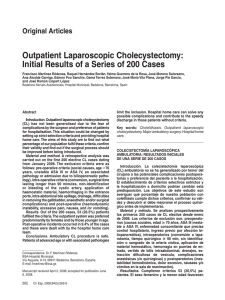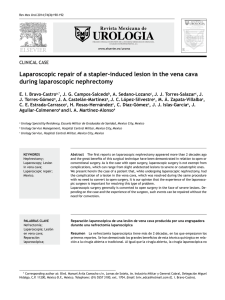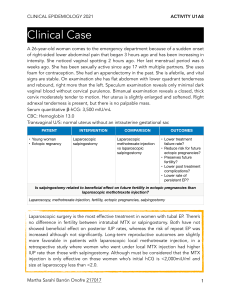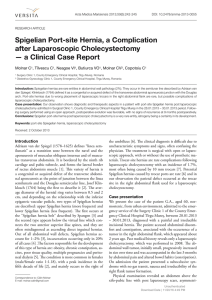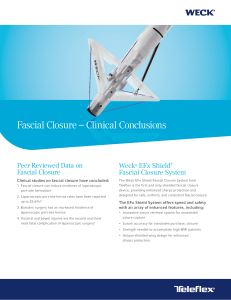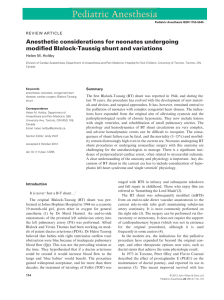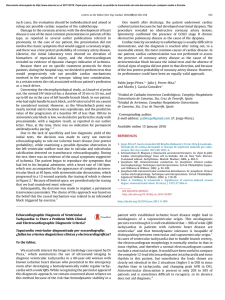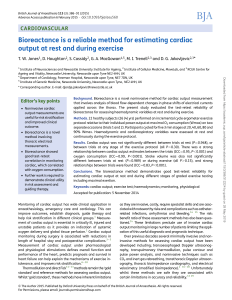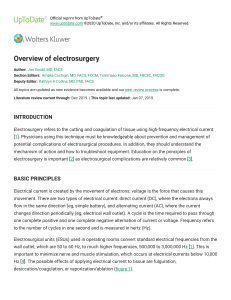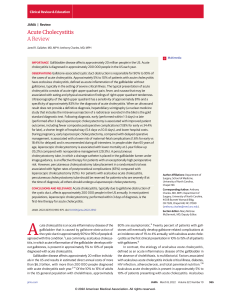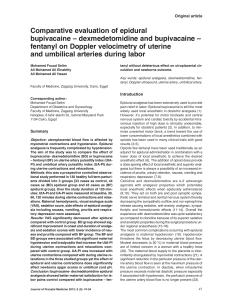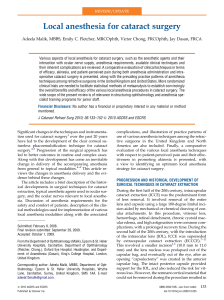Cardiac arrest during laparoscopic cholecystectomy
Anuncio
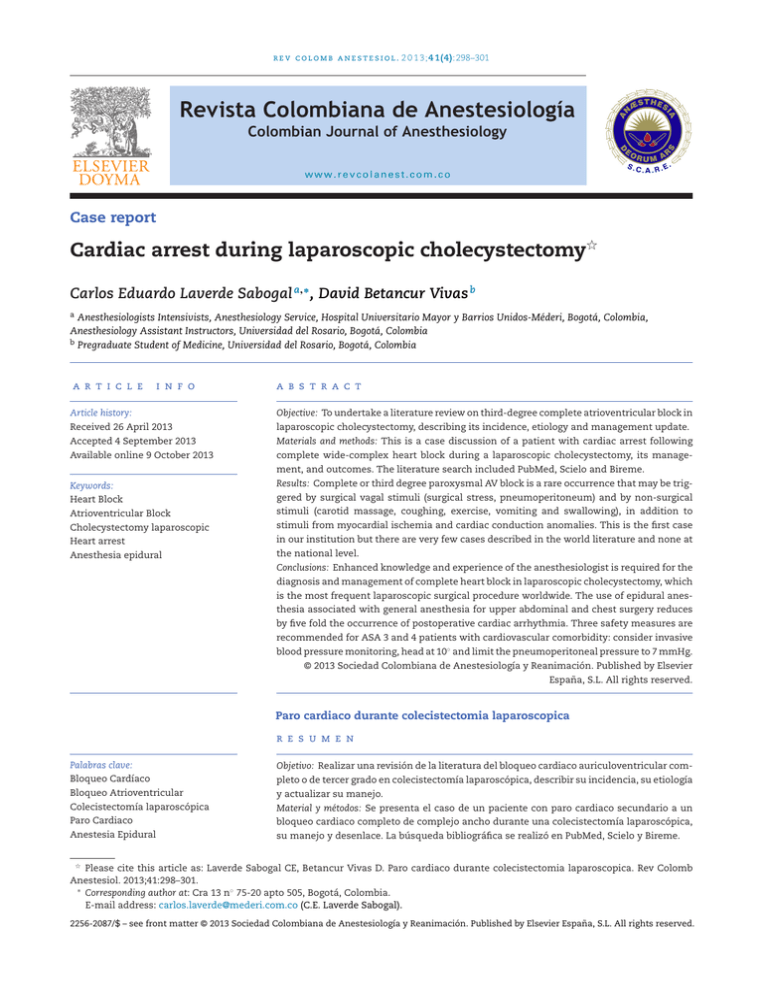
r e v c o l o m b a n e s t e s i o l . 2 0 1 3;4 1(4):298–301 Revista Colombiana de Anestesiología Colombian Journal of Anesthesiology www.revcolanest.com.co Case report Cardiac arrest during laparoscopic cholecystectomy夽 Carlos Eduardo Laverde Sabogal a,∗ , David Betancur Vivas b a Anesthesiologists Intensivists, Anesthesiology Service, Hospital Universitario Mayor y Barrios Unidos-Méderi, Bogotá, Colombia, Anesthesiology Assistant Instructors, Universidad del Rosario, Bogotá, Colombia b Pregraduate Student of Medicine, Universidad del Rosario, Bogotá, Colombia a r t i c l e i n f o a b s t r a c t Article history: Objective: To undertake a literature review on third-degree complete atrioventricular block in Received 26 April 2013 laparoscopic cholecystectomy, describing its incidence, etiology and management update. Accepted 4 September 2013 Materials and methods: This is a case discussion of a patient with cardiac arrest following Available online 9 October 2013 complete wide-complex heart block during a laparoscopic cholecystectomy, its management, and outcomes. The literature search included PubMed, Scielo and Bireme. Keywords: Results: Complete or third degree paroxysmal AV block is a rare occurrence that may be trig- Heart Block gered by surgical vagal stimuli (surgical stress, pneumoperitoneum) and by non-surgical Atrioventricular Block stimuli (carotid massage, coughing, exercise, vomiting and swallowing), in addition to Cholecystectomy laparoscopic stimuli from myocardial ischemia and cardiac conduction anomalies. This is the first case Heart arrest in our institution but there are very few cases described in the world literature and none at Anesthesia epidural the national level. Conclusions: Enhanced knowledge and experience of the anesthesiologist is required for the diagnosis and management of complete heart block in laparoscopic cholecystectomy, which is the most frequent laparoscopic surgical procedure worldwide. The use of epidural anesthesia associated with general anesthesia for upper abdominal and chest surgery reduces by five fold the occurrence of postoperative cardiac arrhythmia. Three safety measures are recommended for ASA 3 and 4 patients with cardiovascular comorbidity: consider invasive blood pressure monitoring, head at 10◦ and limit the pneumoperitoneal pressure to 7 mmHg. © 2013 Sociedad Colombiana de Anestesiología y Reanimación. Published by Elsevier España, S.L. All rights reserved. Paro cardiaco durante colecistectomia laparoscopica r e s u m e n Palabras clave: Objetivo: Realizar una revisión de la literatura del bloqueo cardiaco auriculoventricular com- Bloqueo Cardíaco pleto o de tercer grado en colecistectomía laparoscópica, describir su incidencia, su etiología Bloqueo Atrioventricular y actualizar su manejo. Colecistectomía laparoscópica Material y métodos: Se presenta el caso de un paciente con paro cardiaco secundario a un Paro Cardiaco bloqueo cardiaco completo de complejo ancho durante una colecistectomía laparoscópica, Anestesia Epidural su manejo y desenlace. La búsqueda bibliográfica se realizó en PubMed, Scielo y Bireme. 夽 Please cite this article as: Laverde Sabogal CE, Betancur Vivas D. Paro cardiaco durante colecistectomia laparoscopica. Rev Colomb Anestesiol. 2013;41:298–301. ∗ Corresponding author at: Cra 13 n◦ 75-20 apto 505, Bogotá, Colombia. E-mail address: [email protected] (C.E. Laverde Sabogal). 2256-2087/$ – see front matter © 2013 Sociedad Colombiana de Anestesiología y Reanimación. Published by Elsevier España, S.L. All rights reserved. 299 r e v c o l o m b a n e s t e s i o l . 2 0 1 3;4 1(4):298–301 Resultados: El bloqueo cardiaco auriculoventricular completo o grado III paroxístico es una entidad poco frecuente y que puede ser desencadenada por estímulos vágales quirúrgicos (estrés quirúrgico, neumoperitoneo) y no quirúrgicos (masaje carotideo, tos, ejercicio, vómito y deglución) además de los debidos a isquemia miocárdica y anomalías de conducción cardiaca. Este el primer caso en nuestra institución, existiendo en la literatura médica mundial pocos casos descritos y ninguno a nivel nacional. Conclusiones: Se requiere un mayor conocimiento y experiencia del anestesiólogo en relación al diagnóstico y manejo del bloqueo cardiaco completo en colecistectomía laparoscópica, que constituye la cirugía laparoscópica más frecuente mundialmente. La utilización de anestesia peridural asociada a anestesia general para procedimientos quirúrgicos abdominales altos y torácicos disminuye en cinco veces la aparición de arritmias cardiacas posoperatorias. En los pacientes ASA 3 y 4 con comorbilidad cardiovascular se recomiendan tres puntos de cuidado: considerar monitoreo invasivo de presión arterial, cabecera a 10 grados y limitar la presión de neumoperitoneo a 7 mmHg. © 2013 Sociedad Colombiana de Anestesiología y Reanimación. Publicado por Elsevier España, S.L. Todos los derechos reservados. Introduction Intraoperative arrhythmias are some of the most prevalent complications in daily practice of anesthesia, with an incidence of around 70%.1 Back in 1933 Sachs and Traynor already described Paroxysmal AV block.2 The relationship between ECG changes and acute cholecystitis was described for the first time as “Cope’s sign” or cardiobiliary reflex since 1971.3,4 The incidence of cholecystitis around the world ranges between 2% and 20% and is the most frequent pathology in the elderly, with a prevalence of 21.4% among people 60–69 years and of 27.5% in people over 70 years of age.5 The etiology of paroxysmal AV block includes the presence of a vagal stimulus (surgical stress and pneumoperitoneum) and acute cholecystitis. An average of 1230 laparoscopic cholecystectomies and 25 bariatric surgeries are performed every year at our institution. In a series of 960 patients, elderly individuals undergoing laparoscopic cholecystectomy in Brazil showed an incidence of 1% of cardiac arrhythmia, 0.1% of cardiac ischemia and 0.3% mortality.5 In 1994 Biswas and Pembroke reported the first case of cardiac arrest during laparoscopic cholecystectomy secondary to extreme vagal stimulus.6 The last four cases with similar characteristics were reported in 2009 in India. These cases were successfully managed administering atropine, resuscitation maneuvers and releasing the pneumoperitoneum.7 The paroxysmal AV block is defined as the sudden and repetitive interruption of the atrial impulse lasting over two seconds and is accompanied by ventricular asystole before the electrical conduction is reestablished.8,9 Clinical case presentation 74-Year old patient ASA 2 classification, scheduled for laparoscopic cholecystectomy for cholecystitis–cholelithyasis. Body Mass Index 22, Weight 70 kg. Pathological Background: Dyslipidemia and controlled high blood pressure with losartan 50 mg/12 h, lovastatin 20 mg in the evening, acetylsalicylic acid 100 mg, and metoprolol 25 mg/12 h. History of cigarette smoking. The patient was evaluated by Cardiology because of atypical chest pain with an ECG finding of complete right branch block. A transthoracic ECG showed preserved biventricular function LVEF 65%, left ventricle diastolic dysfunction, mild mitral-aortic sclerosis with negative myocardial perfusion and healthy coronaries according to the arteriogram. Blood chemistry and coagulation were within the normal range. 5-Lead basic hemodynamic monitoring (DII–V5) and capnography were used. The intravenous anesthetic induction was as follows: midazolam 2 mg followed by propofol 120 mg and rocuronium 20 mg; the anesthetic agents were administered intravenously. Anesthetic maintenance with sevoflorane: 2% and remifentanyl: 0.2 mcg/kg/min. The ECG record during the induction of anesthesia showed a normal sinus rhythm. A 7.5 orotracheal tube was used for airway management, symmetrical pulmonary auscultation, normal capnography. The analgesia and antiemesis were performed with tramadol 100 mg, dipirona 3 g and dexamethasone phosphate 8 mg respectively. The surgical procedure began with an approach of the peritoneal cavity through three laparoscopic ports and maximum 15 mmHg pneumoperitoneal pressure. Then the ECG tracing evidenced a 5 s wide-complex grade III atrioventricular block and the surgery was interrupted. Upon the release of the pneumoperitoneum the sinus rhythm was reestablished, the pulsimetry curves were normalized and capnography rendered adequate levels. The pneumoperitoneum was reestablished leading to a new episode of grade III wide-complex AV block, refractory to atropine at a dose of 0.04 mg/kg up to a ceiling 3 mg dose. Subsequently, asystole developed requiring cardiopulmonary resuscitation maneuvers, chest compressions, IV adrenaline 1 mg every 3 min, dopamine infusion at a rate of 10 mcg kg min, in addition to management with a right internal jugular transvenous pacemaker with 100% capture. The carotid pulse was then restored. Transcutaneous pacemakers were not available. Invasive left radial artery blood pressure monitoring was then applied and the open technique surgery was successfully completed. The patient was then transferred to the ICU with vasopressors support (dopamine 5 mcg kg min, and noradrenalin 0.1 mcg kg min), invasive ventilation and 100% pacemaker dependent. No inotropic support was needed. 300 r e v c o l o m b a n e s t e s i o l . 2 0 1 3;4 1(4):298–301 Perioperative arterial gasses show evidence of metabolic acidosis with mild pulmonary dysfunction, 277 PaO2 /FiO2 , normal electrolytes and blood test with 3 mg/dl lactate. Twenty-four hours later the patient is weaned from the invasive ventilator support and vasopressor, with spontaneous recovery of the sinus rhythm. The cardiac enzymes curve was negative and the transthoracic ECG was normal. The Holter test electrophysiological evaluation evidenced a sinus rhythm with ventricular extrasystole and episodes of nonsustained ventricular tachycardia. Thyroid tests were normal. Upon discharge, the patient showed a positive clinical evolution and telephone follow-up for 30 days. Discussion Hemodynamic collapse during laparoscopic surgery may be the result of carbon dioxide (CO2 ) pulmonary embolization, cardiac arrhythmias, vagal responses secondary to peritoneal distention and surgical manipulation. Consider the reduced cardiac preload due to pressures exceeding 15 mmHg in the pneumoperitoneum.10–12 The triggering factors for atrioventricular block are the use of betablockers, AV conduction disruption and vagal stimuli (pneumoperitoneum, vomiting,13 coughing,14 swallowing,15 orthostatic hypotension, pain).16 Shohat-Zabarsky et al., in their series of medical cases, identified precipitating factors such as the use of betablockers in 45% of the cases, vagal reactions in 25%, myocardial ischemia in 45%, administration of local anesthetic agents in dentistry in 10%. In terms of therapeutic management, only 20% received atropine, 80% required placement of a temporary pacemaker and subsequently 50% required implantation of a permanent pacemaker.16 With regard to patients undergoing bariatric surgery, the findings indicate that as a result of their morbid obesity, the use of opioid analgesics and the disruption in the postoperative mechanical ventilation further deteriorate their pre-existing sleep apnea. The strategy suggested in these cases is twofold: NSAIDs analgesia and non-invasive ventilation support to manage the sleep apnea.17 In gynecology a 0.3% cardiac arrest incidence rate is reported in healthy patients undergoing laparoscopic fallopian tube sterilization. In this case, the therapeutic management included: interrupting the surgical stimulus, pneumoperitoneum release and atropine administration with subsequent sinus rhythm recovery.18 Laparoscopic cholecystectomy-related cardiovascular changes are determined by the interaction of three factors: the establishment of the pneumoperitoneum, intra-abdominal pressure and systemic absorption of carbon dioxide (CO2 ), in addition to the association with the induction of anesthesia and a 20◦ inverted Trendelemburg’s position of the patient. The result in healthy patients is dynamic with a biphasic behavior, initially characterized by a drop in heart rate between 35% and 45% of its initial value, with an increase in the mean arterial pressure and the systemic vascular resistance. After 5–10 min of pneumoperitoneum, both the heart output and the systemic vascular resistance are reestablished. In ASA 3 and 4 patients with cardiovascular comorbidity, these hemodynamic changes are enough to cause myocardial ischemia and cardiac arrhythmia. The recommendations for this group of patients are: (1) invasive blood pressure monitoring; (2) head at 10◦ ; (3) limit the pneumoperitoneum pressure to 7 mmHg.19,20 It has been found that the neurohumoral response (adrenalin, noradrenalin, vasopressin, dopamine, cortisol and renin release) in laparoscopic cholecystectomy begins following the establishment of the neumoperitoneum.21 This response may be better modulated with a general balanced anesthesia technique with epidural thoracic anesthesia versus a pure inhalation technique. One of the findings was decreased adrenalin and noradrenalin production when including the thoracic epidural anesthesia, but with no changes in the cortisol release mediated by the hypothalamic–pituitary–adrenal axis suggesting vagal and phrenic nerve conduction pathways that are not affected by epidural anesthesia.22 Gonima and Cols compared the general anesthetic technique versus epidural anesthesia in 52 patients undergoing laparoscopic cholecystectomy. The metabolic response to stress continued unchanged. Cortisol values were higher in the epidural anesthesia group; the responses may be at two levels of insufficient sedation and neuroprotection.23 Along these lines, Oliveira found a fivefold decrease in the incidence of ventricular and supraventricular arrhythmia in patients undergoing upper abdominal and thoracic surgeries with a combination of general and epidural anesthesia versus general anesthesia alone.24 The therapeutic strategy of paroxysmal AV block includes two approaches: the first approach is intended to suppress the vagal stimulus probably triggered by the surgical stimulus and the pneumoperitoneum. The second line of intervention is pharmacological, initially with atropine at a dose of 0.5 mg that may be repeated up to a maximum 3 mg dose (0.04 mg/kg), associated to a dopamine infusion at a chronotropic 5–20 mcg kg min dose. The third line of intervencion is electrical stimulation with placement of a transcutaneos or transvenous pacemaker for refractory cases. When ischemic myocardial pathology is suspected, the dose of atropine should be carefully titrated to avoid extending the ischemic area.25,26 Conclusions The current world trend is toward laparoscopic surgical techniques particularly for cholecystectomy and gynecological procedures. Such scenario leads to a higher frequency of paroxysmal AV block in our patients that requires from us, the anesthesiologists, a timely diagnosis and proper therapeutic intraoperative management, including implanting a transvenous pacemaker to prevent cardiac arrest in 80% of the cases reported.16 Furthermore, an arrhythmogenic etiology different from ischemia should be kept in mind, in addition to consideration of vagal stimuli. The use of epidural anesthesia associated to general anesthesia for upper abdominal and thoracic surgical procedures r e v c o l o m b a n e s t e s i o l . 2 0 1 3;4 1(4):298–301 result in a five-fold decrease in the occurrence of postoperative cardiac arrhythmias.24 Three recommendations are offered in ASA 3 and 4 patients with cardiovascular morbidity: consider invasive blood pressure monitoring, head at 10 degrees and limit the pneumoperitoneum pressure to 7 mmHg.19 Funding Resources own authors. Conflict of interest The authors have no conflicts of interest to declare. references 1. Bocanegra J, Caicedo J. Arritmias intraoperatorias: nodo sinusal enfermo manifestado durante anestesia general. Rev Colomb Anestesiol. 2011;39:259–65. 2. Sachs A, Traynor RL. Paroxysmal complete auriculo-ventricular heart-block. A case report. Am Heart J. 1933;9:267–71. 3. O’Reilly MV, Krauthammer MJ. “Cope’s sign” and reflex bradycardia in two patients with cholecystitis. BMJ. 1971;2:146. 4. Franzen D. Complete atrioventricular block in a patient with acute cholecystitis: a case of cardio-biliary reflex? Eur J Emerg Med. 2009;16:346. 5. Loureiro ER, Klein SC, Pavan CC, Almeida LDLF, Silva FHP, Paulo DNS. Laparoscopic cholecystectomy in 960 elderly patients. Rev Bras Anestesiol. 2011;38 [newspaper and Internet]. Available from: http://www.scielo.br/rcbc 6. Biswas TK, Pembroke A. Asystolic cardiac arrest during laparoscopic cholecystectomy. Anaesth Intensive Care. 1994;22:289–91. 7. Gautam B, Shrestha BR. Cardiac arrest during laparoscopic cholecystectomy under general anaesthesia: a study into four cases. Kathmandu Univ Med J (KUMJ). 2009;7:280–8. 8. El-Sherif N, Scherlag BT, Lazzara R. Experimental model study of Mobitz type II and paroxismal atrioventricular block. Am J Cardiol. 1974;34:309–17. 9. El-Sherif N, Scherlag BT, Lazzara R. An appraisal of second degree and paroxysmal atrioventricular block. Eur J Cardiol. 1976;4:117–30. 301 10. Cunningham AJ, Brull SJ. Laparoscopic cholecystectomy: anesthetic implications. Anesth Analg. 1993;76:1120–33. 11. Carmichael BE. Laparoscopy: cardiac consideration. Fertil Esteril. 1971;22:69–70. 12. Valentin M, Tulsyan N. Recurrent aystolic cardiac arrest and laparoscopic cholecystectomy: a case report and review of the literature. JSLS. 2004;8:65–8. 13. Mehta D, Saverymuttu SH, Camm AJ. Recurrent paroxysmal complete heart block induced by vomiting. Chest. 1988;94:433–5. 14. Lee D, Beldner S, Pollaro F, Jadonath R, Maccaro P, Goldner B. Cough-induced heart block. PACE. 1999;22:1270–1. 15. Bortolotti M, Cirignotta F, Labo G. Atrioventricular block induced by swallowing in a patient with diffuse esophageal spasm. JAMA. 1982;248:2297–9. 16. Shohat-Zabarski R, Iakobishvili Z, Kusniec J, Mazur A, Strasberg B. Paroxysmal atrioventricular block: clinical experience with 20 patients. Int J Cardiol. 2004;97: 399–405. 17. Block M. Heart block in patients after bariatric surgery accompanying Sleep apnea. Obesity Surg. 2001;11:627–30. 18. Sprung J. Recurrent complete heart block in a healthy patient during laparoscopic electrocauterization of the fallopian tube. Anesthesiology. 1998;88:1401–3. 19. Wahba RW, Béïque F, Kleiman SJ. Cardipulmonary function and laparoscopic cholecystectomy. Can J Anaesth. 1995;42:51–63. 20. Joris LT, Noirot DP, Legrand MJ, Jacquet NJ, Lamy LM. Hemodimanic changes during laparoscopic cholecystectomy. Anesth Analg. 1993;76:1067–71. 21. Joris LT, Lamy LM. Neurocrine changes during pneumoperitoneum for laparoscopic cholecystectomy. Br J Anaesth. 1993;70:A33. 22. Aono H. Stress responses in three different anesthesic techniques for carbon dioxide laparoscopic cholecystectomy. J Clin Anesthesia. 1998;10:546–50. 23. Gonima E, Martinez J, Perilla C. Anestesia general vs anestesia peridural en colecistectomía laparoscópica. Rev Colomb Anestesiol. 2013;35:203–13. 24. Oliveira RM, Tenório SB, Tanaka PP, Precoma D. Control del Dolor por Bloqueo Epidural y Aparición de Arritmias Cardíacas en el Postoperatorio de Procedimientos Quirúrgicos Torácicos y Abdominales Altos: Estudio Comparativo. Rev Bras Anestesiol. 2012;62:10–8. 25. Field J, Hazinski M, Sayre M. American heart association guidelines for cardiopulmonary resuscitation and emergency cardiovascular care science. Circulation. 2010;122 18 Suppl.:3. 26. Lorentz MN, Vianna BSB. Arritmias Cardiacas y anestesia. Rev Bras Anestesiol. 2011;61:805–13.
